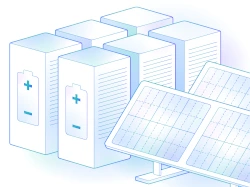Net Energy Metering, often referred to as NEM, is widely considered one of the most important policy mechanisms that have allowed customer-sited solar to flourish over the last 20 years. NEM policies effectively allow behind-the-meter solar customers to sell their exported electricity back to the utility at the retail rate. The customer receives a credit on their utility bill, which offsets against the electricity they consume. By allowing solar customers to sell power back to the grid, this effectively reduces the amount of electricity the customer needs to purchase from the utility. Today, roughly 40 states offer some form of net metering according to the DSIRE database from the NC Clean Energy Technology Center. However, the specific NEM rules can vary dramatically from state to state and in some cases utility territory to utility territory.
Current NEM Policies in Massachusetts
Net Metering policy in the Commonwealth of Massachusetts has evolved significantly over the last decade. Five years ago, there was a more uniform approach to valuing exported energy throughout the state. Today MA’s NEM policies are somewhat nuanced, greyer than they are black and white. This stems from legislation enacted in 2016 that instituted NEM caps in the state, which as we’ll discuss later in this blog, varied depending on the utility company and type of system owner. While full-retail NEM has long since sunsetted for some customers in certain regions, for other customers NEM capacity is still readily available today.
It is important to note that even in Electric Distribution Company (EDC) territories where caps have been hit, some customers are exempt. Homeowners installing a single-phase solar PV system that is 10 kW or smaller are exempt from the NEM cap. Also, small commercial customers on three-phase service, with PV systems under 25 kW are also exempt. The rules and exemptions from the 2016 NEM cap legislation primarily governed the big three regulated utilities in the state: Eversource, National Grid, and Unitil. While municipal-owned electric companies, also referred to as municipal lighting plants (MLPs), are not mandated to offer NEM, most of them do but often with different rules and crediting mechanisms in place. As of 2020, 41 separate communities have established MLP’s within the Commonwealth.
Net Metering Capacity
Given that Massachusetts has a cap on the amount of solar that is eligible for net metering. The first step when identifying a project site is to verify if capacity is available and then file for an Application for Cap Allocation (ACA) through MassACA. The MassACA site gives up-to-date information on current net metering caps within each territory by customer type, along with instructions for filing an ACA. The Net Metering Cap Update table (shown below) is updated weekly and shows Available, Interconnected, Reserved and Pending Capacity for both private and public entities, across the major EDC’s in the state.
As of July 2020, “Private” sector NEM capacity has all been reserved and currently has a waiting list, expect in NStar and National Grid – Nantucket. While “Public” sector NEM capacity is currently available in all EDC territories, but a few are getting close to hitting their cap.
Value of Net Metering in Massachusetts
The customer’s classification determines their amount of kilowatt-hours they receive NEM credit for. If the customer is exempt from the NEM cap, they would receive credit for 100% of their exported kilowatt-hours. NEM cap-exempt customers include:
- Solar systems <10kW for single-phase (typically small and mid-sized residential)
- Solar systems <25kW for 3-phase (typically small commercial)
- Public sector customers
Customers that are not NEM cap-exempt, assuming they can secure NEM cap allocation via the MassACA site, are entitled to receive 60% credit for their exported kilowatt-hours. The DPU (Department of Public Utilities) refers to these as “Market Net Metering credits”. Customers that are not NEM cap-exempt nor able to secure NEM cap allocation are currently not eligible for NEM altogether.
Net Metering credits in Massachusetts can offset both the delivery and supply portions of a customer’s electric bill. To determine a customer’s NEM credit value, we reference the official “Calculation of NEM Credits” language from the DPU Code of Massachusetts Regulation (220 CRM 18.04), which reads:
“100% of the net excess kilowatt-hours, by time-of-use, if applicable, multiplied by the sum of the following Distribution Company charges applicable to the rate class under which the Host Customer takes service:
- Basic service kilowatt-hour charge in the ISO-NE load zone where the Host Customer is located,
- Distribution kilowatt-hour charge,
- Transmission kilowatt-hour charge,
- Transition kilowatt-hour charge.”
This effectively means that NEM cap-exempt customers, who receive credit on 100% of their exports, still have other volumetric, non-bypassable charges (NBCs) on their bill that they would not receive a NEM credit for when solar is exported to the grid. A sample customer bill showing line-item volumetric charges is below.
Customers basically receive the above values and any time-of-use differentials, based on their applicable rate schedule, multiplied by either 100% or 60% of their kilowatt-hours exported to the grid, depending on their NEM eligibility. The table below shows which Class a customer falls into based on the solar PV system size.
NEM Credits carry forward
Each month the EDC will calculate, based on the above criteria, the dollar value of the exported energy. That dollar value is then carried forward from billing period to billing period. A unique feature of NEM in Massachusetts is that those credits can be carried forward for perpetuity, but there is no payout made by the EDC’s. Alternatively, customers with credit balances can elect to virtually offset another utility customer’s usage and bill, assuming they meet certain matching criteria, such as the benefitting meter has to located in the same EDC territory and electric load zone as the generating account.
Lastly, a customer’s NEM dollar credits cannot be applied against demand charges or fixed charges on their bill. There is an exception for class III Net Metering Facilities, which are generally large projects, where the EDC may elect to purchase the remaining credits rather than allocating them towards a future billing period.
Other important Massachusetts NEM mechanics to mention
- Projects are locked in for 25 years from their approved interconnection date.
- Cap exempt projects do not count towards the aggregated total so small projects will continue unabated by NEM policy in the state under the current rulings.
- Exact NEM rates for the calculation above should be evaluated for each EDC as rates change as often as every 6 months. The above notes are guidelines and general rulings from the DPU.
- Massachusetts generally does not differentiate between behind-the-meter NEM and virtual NEM, where electricity is consumed at a site other than where the electricity was generated. For most purposes, including credit calculation, there is no difference between net metering and virtual net metering.
- For more information on Net Energy Metering in Massachusetts see https://www.mass.gov/guides/net-metering-guide.
- Also, be sure to check out our previous blog: Massachusetts solar and energy storage Market – Key Entities, Acronyms and Programs to Know.




